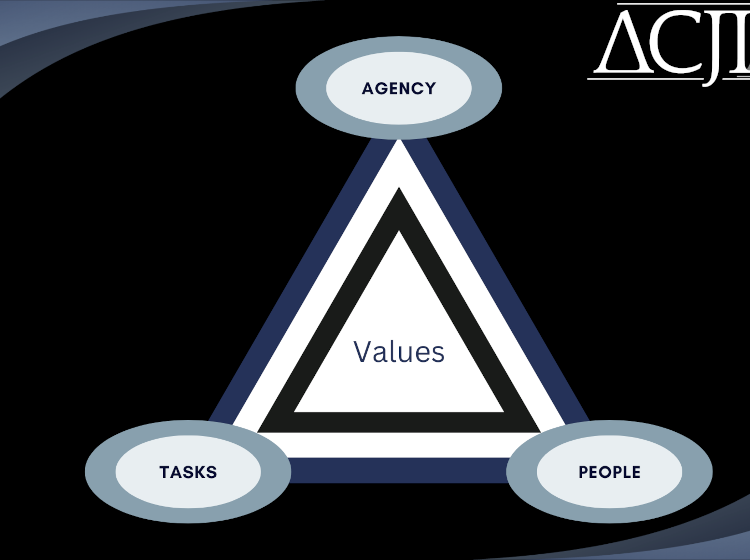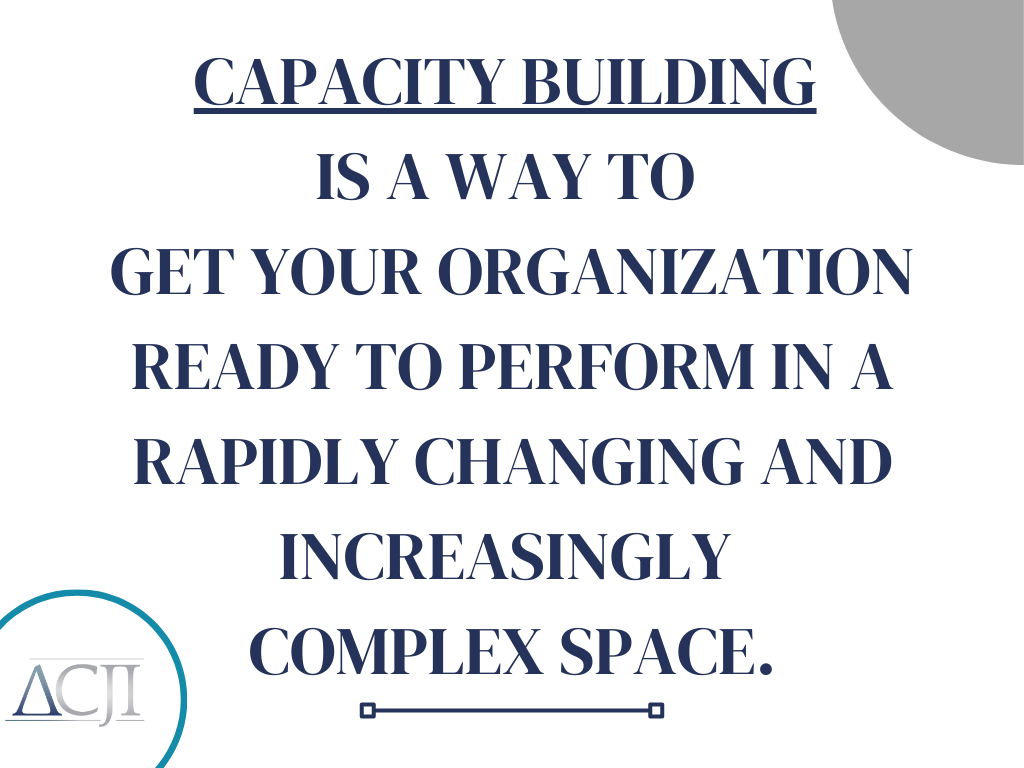What Is Capacity Building? How Does It Fit Into Implementation Science?
August 28, 2024 – When you think of implementation, you likely think of how to begin or revive a program, practice, or another organizational change you hope will stick. This is true, but it is a limited view. There is another component of successful implementation that you cannot always see, and here at ACJI we believe it is essential: It is implementation capacity.
Do you have the human power to adapt to changes and demands as they come your way? Does your culture support the overall direction you are moving in? Are you clear enough about your organization’s North Star to vet ideas and asks as they come?
When trying to shift a team, organization, or even an entire system, the focus is on what we and other implementation scientists call implementation capacity building. It is the work that needs to be done to set an organization up to do its best, most aligned work for years to come, whatever initiatives may come.
Implementation capacity building involves:
- Getting clear on WHY the organization (or team) exists
- Identifying the problems you are best suited to solve
- Defining and supporting a positive org culture
- Identifying the rules, habits, mindsets, policies, and practices that are most aligned with your future best organizational selves and embracing them (while losing the rest)
Side note: Many ACJI Academy Alumni report a better understanding of their selves, too. While our program focuses on justice and human services fields, many of the concepts translate across all industries and even into homes. Need to get everyone to agree on dinner? We have a tool for that.
Using The Why Triangle To Visualize Organizational Capacity
Let’s look at a tool we introduce in ACJI’s Implementation Leadership Academy called The Why Triangle. This tool helps to align your organization’s why with the people of your organization.

The Right Side Of The Triangle: Connection To The Why
On the right side of the Why Triangle graphic is the connection between the organizational why and the people within the organization. This side of the triangle should be a priority for both the implementation teams and the leadership teams.
When people feel disconnected from their agency’s why or when that why shifts over time, it creates a gap between their personal values and the organization’s direction. This dissonance often leads to disengagement, as employees struggle to find meaning in their work or align with the agency’s evolving goals. Ultimately, when this sense of purpose is lost, people either
check out mentally on the job or leave entirely, seeking environments where they feel more aligned. Focusing here is an opportunity to support the people within the organization to do their best work and avoid disengagement and turnover challenges.
<< Learn more about The Why in this other blog post on ACJI.org >>
When you are following implementation science, you create what we call an implementation team. These folks are at the center of the Why Triangle and support the highest level of work.

Left Side Of The Triangle: Avoiding Chaos With The North Star
On the left side of the Triangle, there is a connection between the organization and tasks. When an organization is unclear about why it exists, what problem it is trying to solve, and what its driving values are, you see challenges here.
In real life – in the office – this looks like chaos, and it can happen unintentionally over time as leaders, initiatives, and philosophies for the work come and go. Team members are unsure what they are supposed to do or why they are supposed to do it. People feel pulled in different directions. There are lots of competing commitments. And, over time, it fractures your organizational culture.
The work of implementation leaders is to build capacity within their organization, which in turn gives space for team members to do their best work, and this brings us back to the North Star.
When you know what your North Star is (Ask us how to figure it out if you don’t already know.), you can more easily
- Get clear on high impact strategies
- Clarify goals and set expectations
- Understand your org’s value
- Create organizational culture by design, instead of by default
- Filter new ideas so you know what’s worth focusing on
- Make a quality plan and follow through
Building capacity requires a declaration of what ideal state looks like, and the North Star helps you see what that is. When you know this, you better see what aligns, or doesn’t, with where you want to go.
It is about identifying guardrails, getting rid of or deprioritizing work that is misaligned, and deploying implementation teams with delegated authority to uncover gaps and adaptive challenges to work through them. This work involves mitigating politics and making the tough decisions required to stay focused.
 Get access to short videos and microtechniques for working optimally in high-stress professions with ACJI’s Learn@Work Suite.
Get access to short videos and microtechniques for working optimally in high-stress professions with ACJI’s Learn@Work Suite.
With three tracks, SelfCare@Work, Innovate@Work, and Lead@Work (which includes a video episode about Developing Your Agency’s Why), there is content for all in the business of caring for others.

Bottom Of The Triangle: Be Real About Time
Looking at the bottom of the Why Triangle, there is a connection between individuals and what they spend their time doing. When there is a disconnect between individuals and their tasks, you often see fidelity issues, meaning individuals might be doing tasks but not doing them well, or worse, not doing them at all – and all of this interferes with outcomes.
When you are following Implementation Science, you create what we call an implementation team to address barriers and increase fidelity. They support the highest level of work.
Implementation Capacity Building Definition
When ACJI talks about implementation capacity building, this is what we mean: An intentional process of enhancing an organization’s internal capabilities to support change over time. It is not about any given change initiative, rather the organization’s ability to adapt over time. And it requires intentional focus.
Capacity building includes
- creating a common language and lens to support alignment
- developing people in a way that values innovation
- establishing processes and systems that support adaptation to changing demands.
- creating a culture by design that supports learning, growth, and feedback.
- aiming to strengthen an organization’s overall competence, resilience, and ability to deliver impactful outcomes.
In essence, capacity building is a defined process for a criminal legal system organization to reach its potential success. Following the tenets of implementation science, capacity building improves time management, abilities, and motivation.
How Capacity Building Fits Into Implementation Science
Capacity building is about creating the infrastructure to be able to implement anything. Most organizations that we see operating in government systems, education systems, healthcare systems, and so on, are built to maintain status quo. They aren’t built to be agile and adapt to changing demands and circumstances. Capacity building is a way to get your organization ready to perform in a rapidly changing and increasingly complex space.




